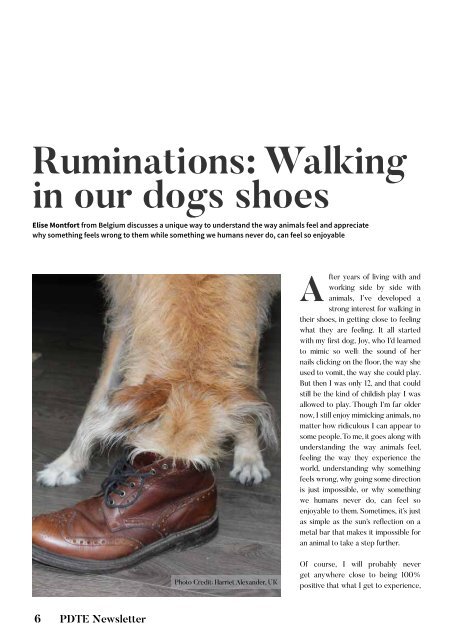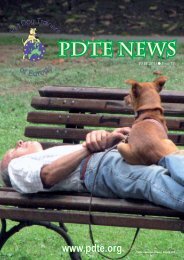PDTE 2016 July Newsletter
You also want an ePaper? Increase the reach of your titles
YUMPU automatically turns print PDFs into web optimized ePapers that Google loves.
Ruminations: Walking<br />
in our dogs shoes<br />
Elise Montfort from Belgium discusses a unique way to understand the way animals feel and appreciate<br />
why something feels wrong to them while something we humans never do, can feel so enjoyable<br />
Photo Credit: Harriet Alexander, UK<br />
After years of living with and<br />
working side by side with<br />
animals, I’ve developed a<br />
strong interest for walking in<br />
their shoes, in getting close to feeling<br />
what they are feeling. It all started<br />
with my first dog, Joy, who I’d learned<br />
to mimic so well: the sound of her<br />
nails clicking on the floor, the way she<br />
used to vomit, the way she could play.<br />
But then I was only 12, and that could<br />
still be the kind of childish play I was<br />
allowed to play. Though I’m far older<br />
now, I still enjoy mimicking animals, no<br />
matter how ridiculous I can appear to<br />
some people. To me, it goes along with<br />
understanding the way animals feel,<br />
feeling the way they experience the<br />
world, understanding why something<br />
feels wrong, why going some direction<br />
is just impossible, or why something<br />
we humans never do, can feel so<br />
enjoyable to them. Sometimes, it’s just<br />
as simple as the sun’s reflection on a<br />
metal bar that makes it impossible for<br />
an animal to take a step further.<br />
Of course, I will probably never<br />
get anywhere close to being 100%<br />
positive that what I get to experience,<br />
when I try to put myself in an animal’s<br />
shoes, is actually what this very animal<br />
is experiencing. But for as long as<br />
I’ve been doing it, I’ve always been<br />
rewarded for it. Indeed, it is beneficial<br />
to try to figure out what an animal is<br />
feeling, to get another perspective on<br />
things. Sometimes, we need to leave<br />
behind every single thing we know<br />
in order to “get it”. Other times, we<br />
need thorough observation together<br />
with a good understanding of the<br />
animal’s ethogram and basic needs<br />
to appreciate and get to feel what’s<br />
going on.<br />
In the end, getting into the process<br />
of feeling and understanding what<br />
an animal is experiencing gives us<br />
accurate and efficient tools to get<br />
to know them better, get to live with<br />
them more respectfully and often also,<br />
change their lives and our lives for<br />
the better. Sometimes, all it takes is<br />
to get down on all fours to get their<br />
perspective. Some other times it’s a<br />
little more complicated. You may just<br />
get lucky and get it right away. In any<br />
case, it always turns out to be worth it.<br />
Recently I was reminded that my<br />
closed mind could be opened by<br />
simple things that would help my<br />
dogs. One of my dogs, Judy, had been<br />
having bouts of stiffness. Even though<br />
we made good use of our osteopath<br />
appointments and regular massages,<br />
tension would stay, reappear, build<br />
up, and she would be in pain again.<br />
There definitely was an urgent need<br />
to have a closer look at her daily<br />
routines and opt for healthier habits<br />
and activities. But at the time, I was<br />
feeling hopeless. There was nothing I<br />
could do to alleviate the burden Judy<br />
was carrying as she was refusing our<br />
regular massages. That’s when luck<br />
popped in! I got the opportunity to<br />
have a light touch session. I realised<br />
how tense I myself was and how<br />
relieving those light touches were.<br />
Moreover, I realised that if I had had<br />
a “real” massage session, I would<br />
Photo Credit: Winkie Spiers, UK<br />
The world can look very different from a dog’s perspective. Getting an idea of their world<br />
view can tell us a lot about why our dogs behave the way they do<br />
probably have felt uncomfortable. Immediately I thought of Judy: could it be as<br />
simple as that? Could light touches be the answer she needed at that particular<br />
moment? Just that? I couldn’t wait to give it a try… And yes Judy loved it!<br />
I also recall something my dogs, Judy and Kimba, taught me (our dogs tend<br />
to teach us quite a few things, don’t they?). At the time, there was quite a bit<br />
of tension and every day was a challenge for the three of us. Communicating<br />
properly and understanding each other was a big deal. But then, we had a few<br />
nights in a row, where everything went well. And every time it did, I noticed that<br />
they would lie down and give a big sigh before falling fast asleep. As soon as<br />
one of them would sigh, I could feel the tension in the room vanish immediately.<br />
I started dreaming that I could initiate the sigh, then I thought of first getting the<br />
feel for it (you’ve got it, I never used to sigh). By now, those of you who practice<br />
it on a daily basis may have raised an eyebrow, and the ones who think it’s silly as<br />
well. But guess what? I felt an immediate relief! After that experience, every time<br />
they would sigh, I would sigh in unison. After a few times, I would actually sigh<br />
by myself if I felt like we could “use” a bit of tension releasing. And they would<br />
usually sigh in unison with me. Now it’s part of our “healthy habits”<br />
We can never put ourselves enough in our animals’ shoes. So, next time you don’t<br />
“get” your dog, just give it a try, as ridiculous as it may make you feel, I can tell<br />
you, you will be as delighted as I always am by what you will discover!<br />
6<br />
<strong>PDTE</strong> <strong>Newsletter</strong> <strong>PDTE</strong> <strong>Newsletter</strong> 7


















